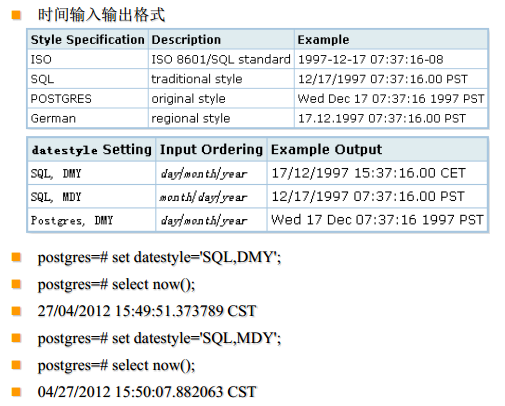

However, static applications can still benefit from the JSON facilities in PostgreSQL by being able to import JSON data from elsewhere very easily, and by being able to export data to JSON very easily. Applications with more dynamic data structure requirements are likely to benefit more. Many ERP applications are fairly fixed in structure, and these are not likely to benefit a great deal from such storage. How could this JSON data type be useful for me? Till now, I haven’t used this in my application.Ī: Not every application will benefit from storing data in a JSON format in the database. Q8: I am working on ERP project which has all its business logic at Database layer. The cost is therefore the same as to cost of updating any field in the table.
POSTGRESQL DATA TYPES UPDATE
So if you update a few values in a 600 key JSON field, it rewrites not just the whole field but the whole row. It’s why PostgreSQL requires far fewer locks than many other database systems. That’s how Multi Version Concurrency Control works. Instead, it creates a new version of the row. How do i update and what is the cost of this update?Ī: PostgreSQL does not ever update a row or a field directly. Q7: I have a JSONB column, which has few 100’s of array elements. It would be far better to store such data in a regular text field and index it with a btree index. Social Security Numbers) should not be stored in JSON. Q6: If there are data points that will be queried more often and also sortable, is it still ok to store that data in JSONB?Ī: In general, data that has a known data type and well understood values (e.g. This would be a very good case for doing thorough benchmarking. Q5: Is it more efficient to put some fields together in a JSON field and index them, compared to having multiple fields each with their own index?Ī: It’s possible that it could be more efficient, but it’s very dependent on the data. They store the data in different ways – JSON stores the data as text and JSONB stored the data in a decomposed format, which allows us to process it far more efficiently. You can have a column of one type or the other. Do you have any example? It is hard to understand as I’m from SQL RDBMS background.Ī: JSON and JSONB are both PostgreSQL data types. Q4: What is the difference between JSON and JSONB? For example, JSONB stores structured data whereas JSON stores unstructured data. Q2: Assuming that I have a following relationship:Ĭreate table foo as select jsonb_build_object(repeat('x',10000),repeat('y',10000000)) In general, if you want indexing, use JSONB.

However, you can use expression indexes on the JSON type using the operators that return text. Q1: Since PostgreSQL 9.4 JSONB supports GIN index, does that means that GIN index has a better performance on JSONB? What about JSON?Ī: There is no direct indexing support at all for the JSON data type, only for the JSONB data type. Andrew Dunstan has taken time to answer those questions below. While Andrew was able to address many questions live, there were several queries that couldn’t be answered due to time restrictions. Those who couldn’t make it to the live session, can now view Introduction to JSON data types in PostgreSQL here. The session was conducted by Andrew Dunstan, Principal Contributor of JSON functionality to PostgreSQL and Senior Developer & PostgreSQL Committer at 2ndQuadrant.Īs promised, the recording of the Webinar is now available. These are listed below: String Data Types: There are mainly five string data types that PostgreSQL supports. These are listed below: Date and Time Data Types: There are mainly five date and time data types that PostgreSQL supports.
POSTGRESQL DATA TYPES SERIES
On 1, 2ndQuadrant held the first in a series of PostgreSQL webinars. Numeric Data Types: There are mainly Nine numeric data types that PostgreSQL supports.


 0 kommentar(er)
0 kommentar(er)
